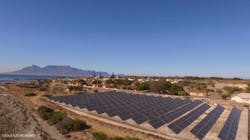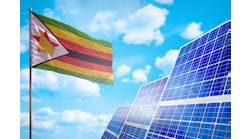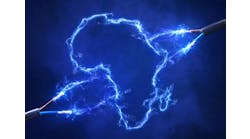Located in Table Bay, 4.3 miles off the coast of Cape Town, Robben Island is a place of special significance in South African and world history. Nelson Mandela spent 18 of his 27 years in prison on the island. Two other post-apartheid South African presidents, including current President Jacob Zuma, were imprisoned there as well.
Robben Island is now a national landmark, wildlife conservation park and U.N. World Heritage site. But the historic island also serves as a modern showcase and model for renewable microgrid and distributed energy technology. Its new solar plus storage microgrid was designed and deployed by international engineering company ABB in partnership with South African energy services company SOLA Future Energy.
Robben Island solar plus storage microgrid
The 667-kW microgrid will supply enough pollution-free electricity to power Robben Island’s facilities for nine months of the year, according to ABB. More than 300,000 visitors a year take the 30-60 minute ferry ride from Cape Town to take guided tours through the Robben Island Museum conducted by former prisoners. The island is owned by the South African government and run by the Department of Tourism. Its 100 museum employees or so live on the island, which is also home to a lighthouse and port.
Previously, the facilities required the combustion of some 158,500 gallons per year of diesel fuel. While the diesel generators will continue to serve primarily as back-up power, the microgrid will reduce greenhouse gas emissions and other environmental pollution associated with diesel generation. In addition, the microgrid will reduce the cost of producing and delivering electricity and enhance energy reliability and resiliency. The project underscores the company’s commitment to a smaller, greener, electric grid, according to ABB.
“ABB’s microgrid solution integrates solar energy and curtails the use of fossil fuels to power Robben Island, bringing substantial cost efficiencies and supporting the Department of Tourism’s efforts to keep the heritage and spirit of this world renowned island alive,” said Claudio Facchin, president of ABB’s Power Grids division.
Rapid diffusion
The remote South African microgrid offers evidence of the increasingly global reach of intelligent and diverse microgrid technology – and of ABB’s efforts. The company’s microgrid group has five teams up and running on five continents, according to Markus Bruegmann, ABB global product manager for microgrids.
“The technology is expanding worldwide, and we’re acting globally. We see similar developments in markets – either mature or emerging,” he said.
The Robben Island microgrid is not grid-connected, but acts as a standalone system. Its key elements consist of an ABB Ability PowerStore lithium-ion battery energy storage system, Microgrid Plus control system and associated secure wireless communications network.
The entire system can be managed remotely from the mainland, with technicians sent to the site as required. Use of wireless digital telecommunications devices eliminated the need to dig cable trenches, helping conserve Robben Island’s unique natural habitat and ecosystems. The island is home to more than 20,000 African penguins, herds of springbok (South Africa’s national mascot), and serves as a bird sanctuary.
“Robben Island should always be a beacon of hope for everyone,” said Vusumzi Mcongo, who was arrested at age 24 and held as a political prisoner on the island for years. Now, at age 63, he is one of the tour guides. “I am positive that the future looks brighter.”
ABB microgrids in South Africa, Kenya
ABB believes South Africa is definitely on its way to installing more renewable power generation in combination with microgrids, despite monopoly utility Eskom’s steadfast reluctance. The commercial and industrial sector looks particularly promising, according to Bruegmann.
The Robben Island microgrid is the second hybrid microgrid ABB has completed in South Africa. The first ABB installed at its Longmeadow (Johannesburg) regional headquarters, manufacturing and logistics center.
“Longmeadow is a commercial microgrid – ABB doesn’t invest in projects that don’t have a high likelihood of producing adequate returns,” he said.
ABB’s microgrid group also has two microgrid projects in Kenya. One is an off-grid community microgrid in a rural area, another is commissioned for the Red Cross at its logistics center in Nairobi that coordinates deliveries of supplies to refugee camps. The company has installed about 40 microgrids worldwide.
As seen in Africa, the company can move quickly to provide power where needed. Typically it takes just two to four weeks for ABB and project partners to deploy hybrid microgrids of the size and capacity to serve Robben Island or Longmeadow.
Track news about solar plus storage microgrid projects. Subscribe to the free Microgrid Knowledge newsletter.








